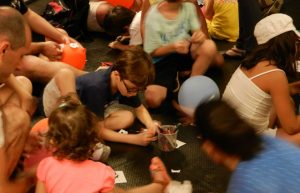The Center for Computation in Engineering and Science and Unicamp’s Exploratory Science Museum have jointly developed interactive workshops on protein folding for elementary and junior high school youth. The workshops will take place during the event Holidays at the Museum, which will take place between July 1 and 16, 2019. Groups of 7 and 8 year old children, up to 14, year olds will be introduced to the science of protein structure discovery and its usefulness in understanding and developing new drugs.
The workshop has four blocks, in which children and young people will be introduced in a playful way to various stages of understanding a pathology at the molecular level: 1) differential diagnosis of a poisonous animal poisoning; 2) identification of objects through projections and capture of world phenomena in the form of digital data; 3) modern scientific equipment, in a guided visit to the National Synchrotron Light Laboratory and, finally, 4) modeling of proteins using physical models and projections, for the recognition of antidotes.

The activities are adapted to the different learning levels of children and young people at different stages of development.
The central argument of the interactive workshop is the healing of a patient who has been bitten by an initially unknown venomous animal. By reproducing the actions of doctors in making a differential diagnosis, the youngsters will identify the agent of poisoning. This action will be related to decision tree concepts and basic machine learning algorithms. They will then learn that the toxin is a protein, a molecule with a specific shape whose structure needs to be determined before a cure can be developed. A visit to the Synchrotron Light National Laboratory will introduce the youngsters to the most modern equipment for determining protein structures. Back at the museum, the race to find a cure will begin! The challenge will be to model the structure of the toxin using physical models, printed in 3D, of the protein chain, seeking to reproduce the shadow of the correct structure. Finally, once the structure is identified, it will fit into a mold that will represent the antigen, necessary to “save” the poisoned patient.
All activities are interactive and collaborative, using software, physical models, and group dynamics developed by the Exploratory Science Museum team in partnership with CCES researchers, and aim to represent all the steps of a modern scientific study in the area of molecular modeling and pharmacology. In particular, the importance of using technological and computational resources in modern science, which is a central theme of CCES, will be demonstrated.
In two days of science and exploration, children and youth will practice the fundamental elements of scientific thinking: reasoning by induction, experimental measurements, modeling, and applications!
More details about the event are available at http://www.mc.unicamp.br
Translated with www.DeepL.com/Translator (free version)

